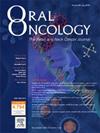牙龈髓外浆细胞瘤1例报告及临床处理
IF 4
2区 医学
Q1 DENTISTRY, ORAL SURGERY & MEDICINE
引用次数: 0
摘要
牙龈髓外浆细胞瘤(EMP)是一种非常罕见的浆细胞肿瘤,由于其非特异性的临床表现和低发病率,给诊断带来了重大挑战。这个病例报告详细介绍了一个67岁的男性表现为无痛的右侧上颌牙龈肿块,最初模仿良性增生。诊断检查,包括锥形束计算机断层扫描(CBCT),显示溶骨性骨破坏和软组织扩张。组织病理学和免疫组化(IHC)分析证实单克隆浆细胞增殖(CD38+, CD79a+, MUM-1+, κ轻链限制),Ki-67指数显著升高(80%)。根治性手术切除达到R0边缘,在完全切除的基础上推迟辅助放疗。该病例强调了关键的诊断考虑:EMP必须与慢性牙龈炎,b细胞淋巴瘤和头颈部恶性肿瘤区分开来,免疫组织化学(CD138, κ/λ限制)和PET-CT是关键工具。观察到的Ki-67升高与EMP中与孤立性骨浆细胞瘤相比具有更高的增殖活性的证据一致,强调了风险适应辅助治疗对Ki-67和gt肿瘤的作用;50%。此外,κ-轻链优势(> 90%)强调了克隆增殖动力学,而对多发性骨髓瘤的系统性进展的纵向监测仍然是必要的。本报告提倡对非典型口腔病变进行早期活检、多学科合作和终身监测,以减轻诊断延误和优化结果。它强调了将分子分析(例如1q21/MYC状态)整合到这种罕见实体的预后模型中的重要性,最终指导精确的管理策略。本文章由计算机程序翻译,如有差异,请以英文原文为准。
Extramedullary plasmacytoma of the Gingiva: A rare case report and clinical management
Extramedullary plasmacytoma (EMP) of the gingiva is an exceptionally rare plasma cell neoplasm, posing significant diagnostic challenges due to its nonspecific clinical presentation and low incidence. This case report details a 67-year-old male presenting with a painless right maxillary gingival mass, initially mimicking benign hyperplasia. Diagnostic workup, including cone-beam computed tomography (CBCT), revealed osteolytic bone destruction and soft tissue expansion. Histopathological and immunohistochemical (IHC) analyses confirmed monoclonal plasma cell proliferation (CD38+, CD79a+, MUM-1+, κ-light chain restriction) with a markedly elevated Ki-67 index (80 %). Radical surgical resection achieved R0 margins, and adjuvant radiotherapy was deferred based on complete excision. The case highlights critical diagnostic considerations: EMP necessitates differentiation from chronic gingivitis, B-cell lymphomas, and head/neck malignancies, with immunohistochemistry (CD138, κ/λ restriction) and PET-CT serving as pivotal tools. The observed Ki-67 elevation aligns with evidence suggesting higher proliferative activity in EMP compared to solitary bone plasmacytomas, emphasizing the role of risk-adapted adjuvant therapy for tumors with Ki-67 > 50 %. Furthermore, κ-light chain predominance (>90 %) underscores clonal proliferation dynamics, while longitudinal surveillance for systemic progression to multiple myeloma remains imperative. This report advocates for early biopsy of atypical oral lesions, multidisciplinary collaboration, and lifelong monitoring to mitigate diagnostic delays and optimize outcomes. It underscores the importance of integrating molecular profiling (e.g., 1q21/MYC status) into prognostic models for this rare entity, ultimately guiding precision management strategies.
求助全文
通过发布文献求助,成功后即可免费获取论文全文。
去求助
来源期刊

Oral oncology
医学-牙科与口腔外科
CiteScore
8.70
自引率
10.40%
发文量
505
审稿时长
20 days
期刊介绍:
Oral Oncology is an international interdisciplinary journal which publishes high quality original research, clinical trials and review articles, editorials, and commentaries relating to the etiopathogenesis, epidemiology, prevention, clinical features, diagnosis, treatment and management of patients with neoplasms in the head and neck.
Oral Oncology is of interest to head and neck surgeons, radiation and medical oncologists, maxillo-facial surgeons, oto-rhino-laryngologists, plastic surgeons, pathologists, scientists, oral medical specialists, special care dentists, dental care professionals, general dental practitioners, public health physicians, palliative care physicians, nurses, radiologists, radiographers, dieticians, occupational therapists, speech and language therapists, nutritionists, clinical and health psychologists and counselors, professionals in end of life care, as well as others interested in these fields.
 求助内容:
求助内容: 应助结果提醒方式:
应助结果提醒方式:


